DIY: 4age Valve Stem Seals.
How to by assassin10000
More write-up goodness…
Just a short time ago I started getting the dreaded blue smoke at startup out the tailpipe, and it eventually began to happen when leaving stop lights after sitting for a while. I realized that I was starting to loose/burn more oil than my strong running motor normally did during high rpm hard use. I figured given the way it was burning off with no loss of power. That it was time the change the valve stem seals, which is a pretty common failure on a 20+ year old 4AGE engine. Here’s a little write-up on how to D.I.Y. with some pictures. Done while the motor is still in the car using hand tools, and the handy rope trick.
The basics of this writeup can be applied to just about any DOHC engine, with variences due to design and parts used.
To start off with you will need a special tool, without this or something else to compress the valve springs and remove the keepers you are S.O.L. (Thanks go to rix86 for pointing me in the right direction to get this very necessary tool.)
1. Special tool.

Available from Snap-On. Part/Stock #: GA317
http://buy1.snapon.com/catalog/item.asp?P6…ore&dir=catalog
2. Remove top timing belt cover.
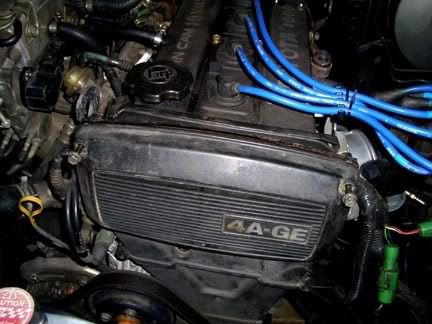
3. Disconnect items on top end that will interfere; EGR modulator & bracket, brake booster hose, pcv hose, and strut tower bar if you have one.

4. Remove sparkplug wires and distributor cap as one.
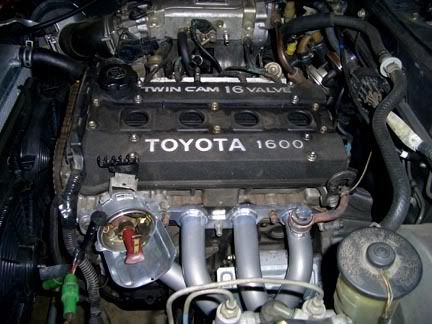
5. Remove distributor. Stuff a paper towel or rag into the hole to keep oil from dripping out.
Tip: mark it’s position as seen in the upper left corner of the picture with some whiteout before removal, this way you most likely WON’T have to make any timing adjustments on reinstallation.
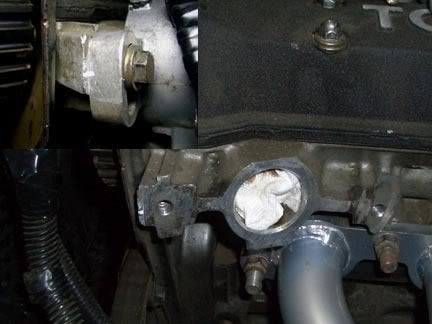
6. Remove tension on the timing belt, you can remove the plug from the middle/center timing belt cover to access the tensioner bolt (Or remove the cover now which is covered step #9). Loosen tensioner bolt and retighten so belt is slack.

7. Slide belt off cam gears and let hang.
It doesn’t need to be removed from the crankshaft gear unless you want to do a timing belt at the same time. (I replaced my timing belt, it was needed on my car but wont be covered in this write-up. I’m assuming if attempting this you have the mechanical ability necessary to change a timing belt at least ![]() )
)
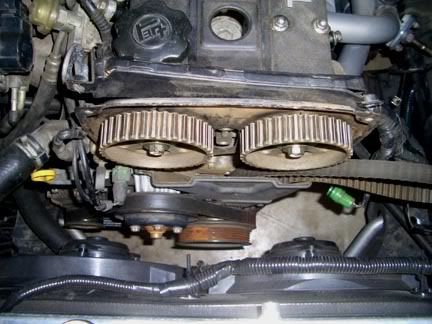
8. Remove cam gears.
Tip: if stuck use two small pry bars to work the camgear loose from the end of the camshaft. Also, use a small pry bar through a hole in the cam gear against one of the 10mm bolts holding the rear metal timing cover to the cylinder head to stop the cam gear from rotating when you are loosening the bolt.

9. Remove center/middle timing belt cover. Unfortunately to do this you need to remove the waterpump pulley and belt. Note: if you have a fan clutch still you will probably have to remove the upper fan shroud to get the fan blade and clutch out.
Tip: loosen the bolts on the waterpump BEFORE removing the belt.
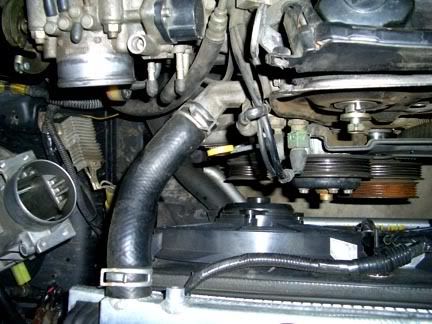
10. Remove rear timing cover/plate. This picture shows the lower 10mm that isn’t accessable unless you remove the middle cover.
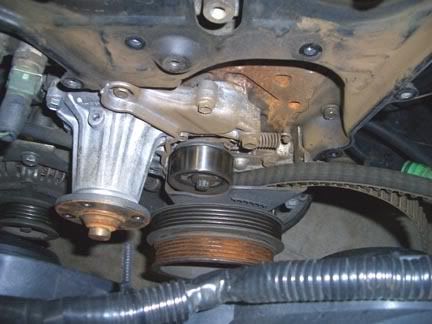
11. Now that you have all the front stuff apart, remove the valve covers. I use a small flat tip to ‘work’ the cover seals up and off. Remove old FIPG from 90 degree corners of valve cover where the cam caps meet the cylinder head.
Tip: smack the v/c with the palm of your hand sideways to loosen it from the cyl head for removal. Also, get new valve cover seals unless you’ve recently replaced them.
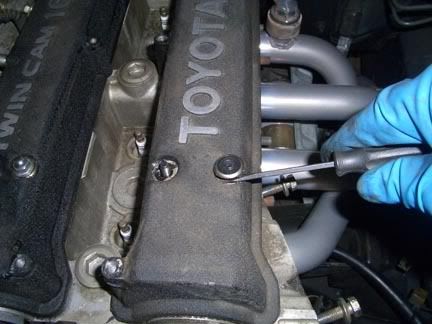
12. Loosen cam caps in reverse order of installation (see pic on step #27). Then loosen each a few turns at a time so as NOT to damage the cam caps. Then remove camshafts. Don’t forget to clean the old FIPG off of the front cam caps.
Tip: if you have limited workspace you can remove each cam individually and do the work one side at a time.
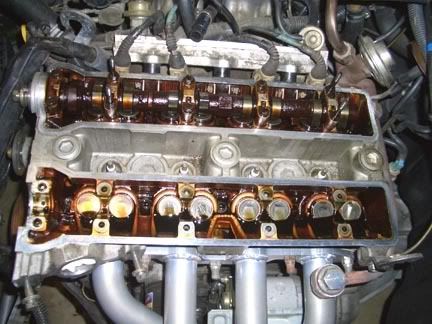
13. Now, how to keep the valves from falling into the cylinder once you remove the valve spring retainers & keepers. This can be done a few ways:
A. Use an air compressor and adapter to put 100+ psi of pressure to hold valve up.
B. Using 1/4″ or less diameter rope inside the cylinder. (which is what I will cover in this write-up.)
Remove all the spark plugs (do this for either A or B.)
Feed rope into the combustion chamber of the valves you will be working on; with the cylinder at BDC (bottom dead center, cyl at bottom of stroke) I used approx 6.5-7.5 feet of 1/4″ thick rope.
Rotate the crank by hand until it stops moving. At this point the rope should be crushed by the piston into the cylinder head and valves and will prevent them from dropping in.
Remember this step HAS to be repeated for each cylinder you work on for steps #16 thru 25.
Tip: use a cotter pin to keep the rope from being able to drop into the cylinder, this can be seen in the pic.

14. Use a magnetic tool to lift out the both the valve shim and bucket at once.
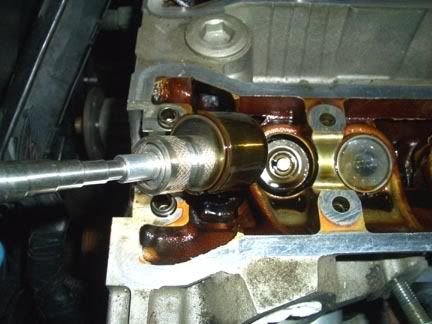
15. When setting everything to the side(IE: on a workbench, tray, cardboard, ect.) Be sure to keep the buckets & shims in order so you DON’T have to do a valve adjustment when all is said and done. BUT, if you haven’t done a valve adjustment within the last 90-120k miles. Now would probably be the time.
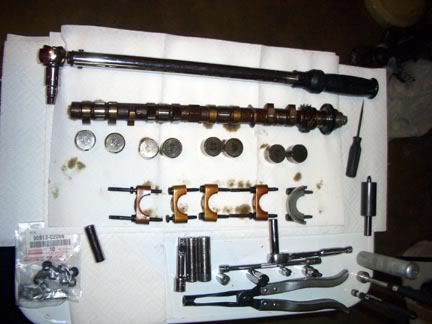
16. Onto the fun stuff. Get your special valve keeper installer/remover tool. Grab the aluminum handle portion, it has a magnet in the hollow center. When you press down with the tool (which is NOT hard to do) by hand, it will suck the keepers into the tool and the retainer & spring is now loose.
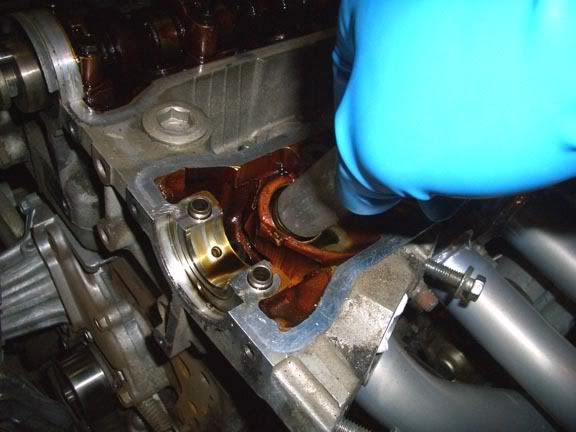
17. This is what will happen once it’s loose. The magnet is just strong enough that it will lift both the keepers and retainer off the valve spring once it’s loose.
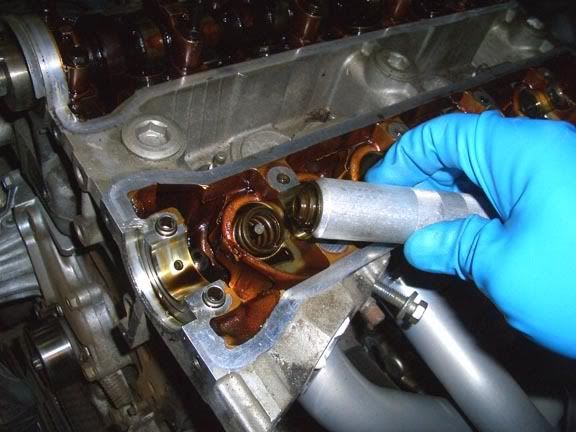
18. Here’s a pic of the retainers in the tool. I simply grabbed another magnetic pickup tool and sucked them off the magnet inside the tool to the pickup tool for easy removal.
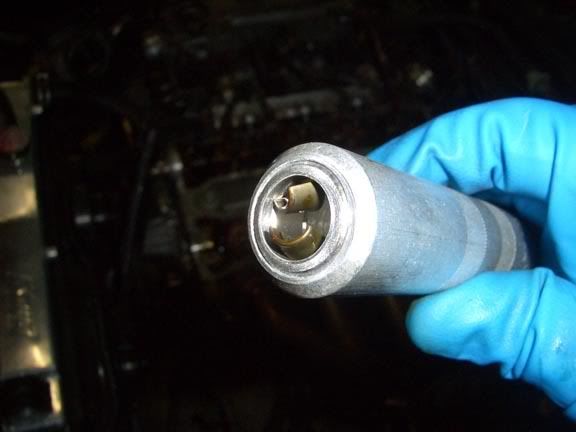
19. Remove valve spring. Note: when you remove it the portion facing down will have a smaller/tighter wound coil at the bottom. Upon reinstallation this portion HAS to be on the bottom.
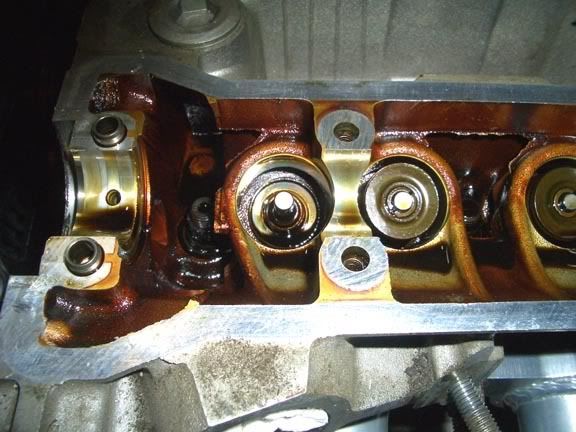
20. Remove the valve stem seal. You can either get some valve stem seal pliers, or grab them with some larger needle nose pliers. They aren’t all that difficult to remove. BUT, be somewhat careful not to score/damage the sides of the bucket opening in the cyl head.
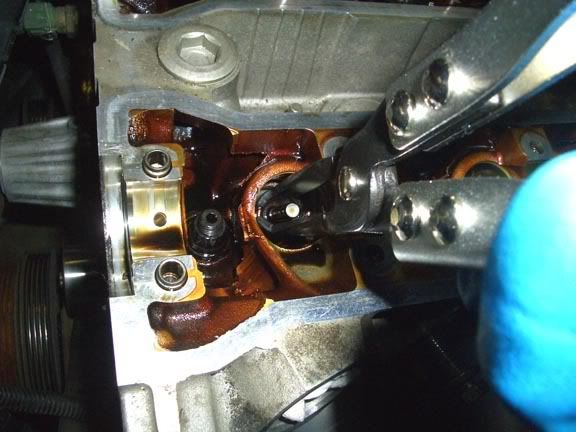
21. Picture of the old valve stem seal in valve stem seal pliers.
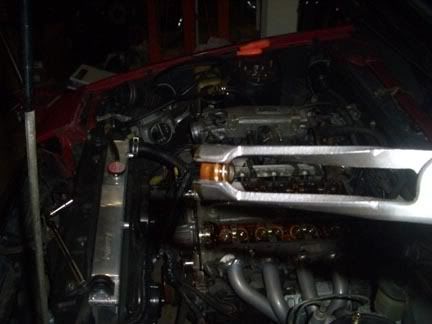
22. New valve stem seals, and the 11mm 1/4″ socket used to install them. A not-so-special tool ![]() .
.
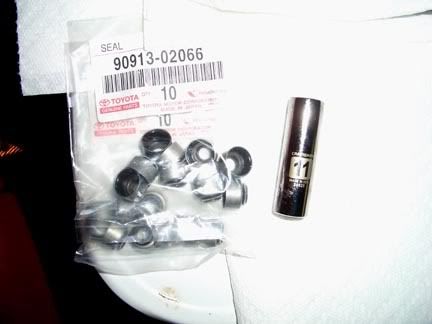
23. Apply some fresh oil to the end of the valve, then slip the valve stem seal over the end.
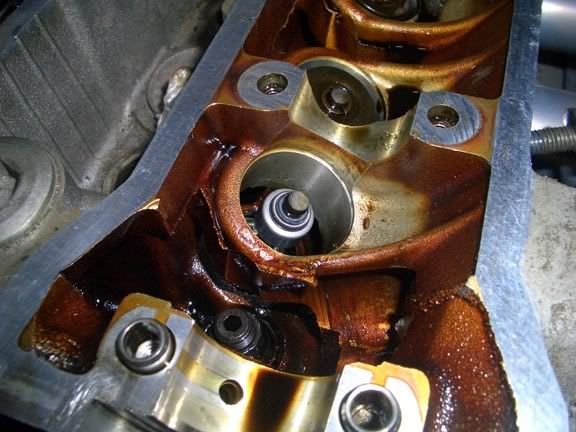
24. Grab the 11mm socket and just press downwards until the valve stem seal seats in place. You will be able to feel when it starts going over the valve guide, and stops once in place. It doesn’t take a whole lot of pressure, just using your thumb should be more than enough.
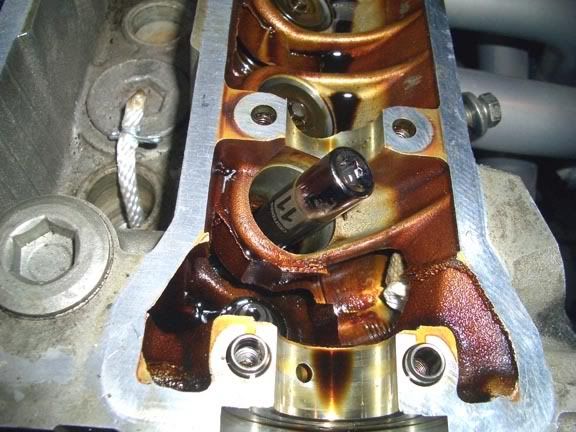
25. Now to reinstall the valve spring, retainer & keepers. Put the valve spring back into the shim bucket bore, make sure the smaller/tighter wound portion of the valve spring is facing down.
Grab the retainer & keepers, slip the keepers into the retainer like so:
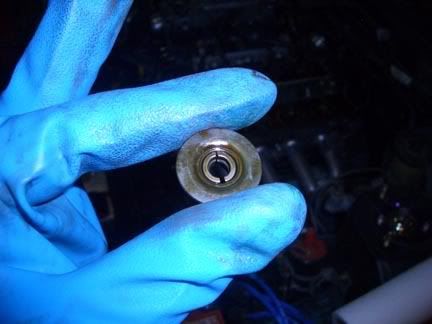
Slip the 2nd part (spring loaded installer) of the special tool into the 1st part (aluminum handle). Then set the spring loaded guide into the keepers:
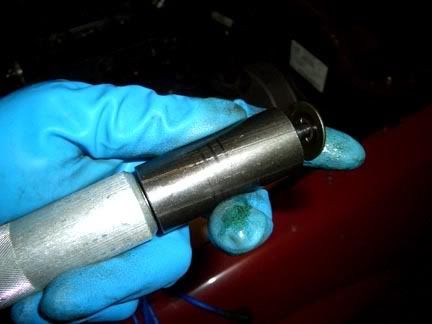
It will look like this.

Now take it over to the valve & spring it’s to be installed on. Place down onto the valve spring and move it around a little until it slips over the end of the valve stem, you will be able to feel this.

All you need to do at this point is push down until the keepers clip/snick into place. You will feel this and just lift the tool off when you do. It should look like this once it is in place.
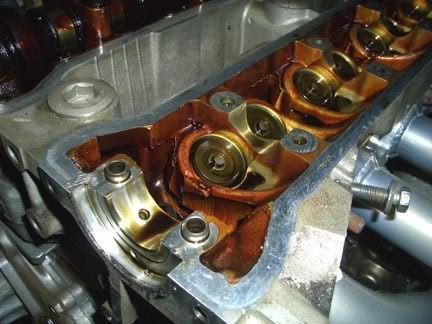
26. REPEAT steps 13, and 16-25 as necessary to replace all 16 valve stem seals.
27. Reinstall camshafts:
A. Reinstall the shims & buckets in the proper order.
B. Put fresh oil on camshaft journals, and the shims.
C. Place camshaft into position with cam seal.
D. Grab the cam caps and apply fresh oil to the journal portion & the threads of the bolts
E. Apply a small amount of FIPG to the corner of the front cam caps, at the area of the cam cap around where it meets the camseal.
F. Put a little fresh oil over all the camshaft lobes.
G. Run down all the bolts a few turns at a time until the cam caps are flush with the cylinder head. You want to do this a few turns at a time or it will crush the edges/sides of the cam caps because the cam lobes will be pushing upwards in certian spots and the warp if not brought down evenly is enough to cause damage.
H. Torque the cam caps in the order shown in the picture below. Be sure to torque it in several increments with an ‘inch-pound’ torque wrench.
I recommend the first torque be at 54 in-lbs, 2nd at 81 in-lbs, and 3rd at 108 in-lbs (108 inch lbs = 9 foot lbs which is the factory torque spec)
Camshaft journal cam torque order. 1= first, 5=last. (when loosening use reverse order)
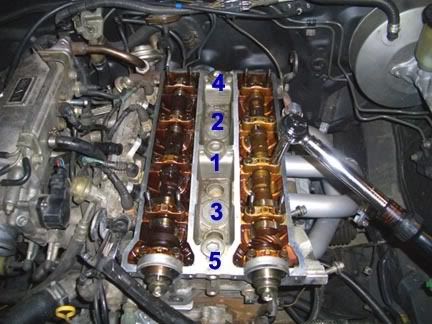
28. Reinstall valve covers. You will need to put just another small amount of FIPG on the 2 hard corners of the v/c gasket where the cam caps meet the cylinder head.
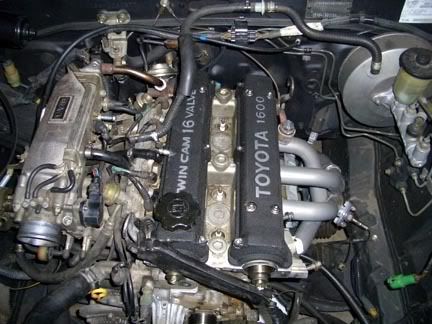
29. Reassemble your engine/timing components in reverse order.
30. A picture of tools that I used for this job. The ONLY thing not pictured is a timing light.

~~~~~~~~~~~~~~~~~~~~~~~~~~~~~~~~~~~~~~~~~~~~~~~~~~~~~~~~~~~~~~
A few notes to help on reassembly:
Change your oil, just drain it at first and change the filter. Complete the work on the valve stem seals. Use a little of the new oil to lubricate the camshafts, journals and components. Then once the valve covers are back on fill it up.
Cam gear bolt torque is 34 ft-lbs.
Tip: use a small pry bar through the cam gear holes against one of the 10mm bolts that hold the rear timing cover. This will hold the cam gear still when your trying to torque it.
Valve cover nuts should just be tightened until ‘snug’. 9-12 ft lbs is plenty. If you used new V/C stud seals, you will need to retorque after a little bit as they do compress.
Stock 4a-ge timing is 10 degrees BTDC. Be sure to check it.
Timing belt should not have more than 4mm or just over 1/8″ deflection/play between cam gears, once the timing belt tensioner is tightened.
Tip: to set tension the easy way, with tensioner bolt loose simply rotate the crankshaft so that 2-3 timing gear teeth go past the alignment marks. Then tighten the tensioner bolt and check deflection/play in between the 2 cam gears.
When reinstalling waterpump pulley & bolts use a ‘strap wrench’ to hold pulley so you can tighten them easier. Note: this is slightly more difficult if you have a fan clutch.
Toyota FIPG can be substituted with Honda-bond (same basic stuff) or Grey Permatex sealant.
~~~~~~~~~~~~~~~~~~~~~~~~~~~~~~~~~~~~~~~~~~~~~~~~~~~~~~~~~~~~~~
I hope you didn’t enjoy doing this as much as I did… Be prepared to spend some time on this job. At least a full day if your not a good AND fast mechanic.
Andrew
p.s. – If you are going to have your cylinder head off for ANY reason (ie: headgasket), I would recommend replacing the valve stem seals. It’s WAY easy when on the workbench, or ground. Just put a rag into the combustion chambers to hold the valves up and set the head down flat on ’em.
Nicely done. Thank you